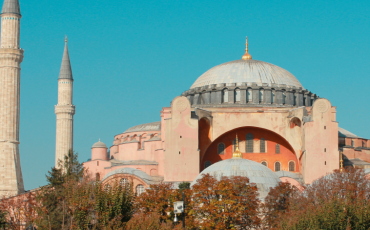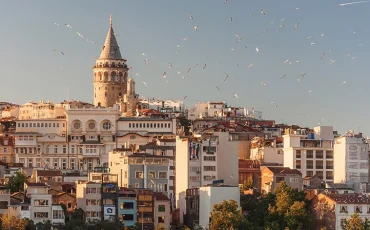What you read in this article:
When one thinks of the grandeur and cultural richness of Istanbul, the mind inevitably turns to the monumental Süleymaniye Mosque, rightfully claiming the title of the biggest mosque in Istanbul. Built during the reign of Suleiman the Magnificent, this architectural marvel stands as the largest Ottoman imperial mosque, a testament to the prowess of the renowned architect Sinan and a symbol of the city’s deep-rooted history.
Origins and Historical Significance
The Süleymaniye Mosque’s history is intertwined with the legacy of Suleiman the Magnificent, one of the most powerful Ottoman rulers. Commissioned by Suleiman in the 16th century, the mosque was intended to reflect not only his piety but also the grandeur of the Ottoman Empire.
The largest mosque in Istanbul, its construction commenced in 1550 and was completed in 1557, marking an era of architectural innovation and imperial splendor.

Architect Sinan’s Masterpiece
At the heart of this colossal structure lies the brilliance of the chief architect, Sinan. His visionary design and engineering feats are evident in every facet of the mosque. Sinan’s meticulous planning resulted in a harmonious blend of domes, minarets, and courtyards that create an awe-inspiring spectacle.
The Süleymaniye Mosque stands as a testament to Sinan’s mastery, showcasing a perfect synthesis of form and function.
Exterior Grandeur
As the largest mosque in Istanbul, the Süleymaniye Mosque dominates the skyline with its majestic domes and minarets. The exterior is a captivating display of Ottoman architecture, drawing visitors in with its intricate details.
The courtyards, adorned with lush gardens and elegant fountains, provide a serene space for contemplation, inviting worshippers and tourists alike to immerse themselves in the mosque’s serene ambiance.
Read More: Just How Many Mosques Are in Istanbul?
Interior Splendor
Stepping inside, visitors are greeted by a world of artistic splendor. Iznik tiles, renowned for their vibrant colors and intricate patterns, adorn the walls, creating a breathtaking visual mosaic. Stained glass windows bathe the interior in a kaleidoscope of hues, while decorative calligraphy imparts a sense of sacred elegance.
The Süleymaniye Mosque’s interior is a testament to the Ottoman commitment to craftsmanship and beauty.
Beyond its prayer halls, the Süleymaniye Mosque boasts mausoleums that house the tombs of Suleiman the Magnificent and his wife Hurrem Sultan. Ascending to the terrace offers panoramic views of Istanbul, providing a unique perspective on the city’s rich tapestry.
The mosque complex, with its hospitals, baths, and kitchens, reflects the Ottoman commitment to holistic community well-being.

Enduring Cultural Relevance
Today, the Süleymaniye Mosque remains an active place of worship and a major cultural landmark in Istanbul. Its continued relevance speaks to the enduring significance of Ottoman architecture and Islamic heritage. The largest mosque in Istanbul, the Süleymaniye Mosque transcends time, inviting visitors to experience the grandeur of a bygone era while embracing the rich cultural tapestry of contemporary Istanbul.
Visiting this iconic site is not just a journey into history; it’s an exploration of architectural brilliance and cultural richness that defines the heart of Istanbul.
Read More: How Old is the Blue Mosque in Istanbul? Discovering the Age of the Blue Mosque
Background on Ottoman Mosque Architecture
Delving into the historical context of the Süleymaniye Mosque requires an understanding of the broader architectural landscape of the Ottoman Empire during the 16th century.
- Ottoman Architectural Legacy: The Ottoman Empire, known for its architectural prowess, left an indelible mark on the world with its distinctive mosque designs. Resource: Ottoman Architecture – UNESCO World Heritage Centre
- Islamic Architectural Principles: Ottoman mosque architecture drew inspiration from Islamic principles, emphasizing geometric patterns, calligraphy, and a focus on creating spiritual spaces. Resource: Islamic Art and Architecture – Metropolitan Museum of Art
- Influence of Byzantine and Persian Styles: The Süleymaniye Mosque reflects a synthesis of Ottoman, Byzantine, and Persian architectural styles, showcasing the empire’s cultural diversity. Resource: Byzantine Architecture – Encyclopaedia Britannica

Süleymaniye Mosque’s History and Significance in Istanbul
The Süleymaniye Mosque’s colossal size makes it the largest mosque in Istanbul, standing as a testament to the ambition and vision of Suleiman the Magnificent. Commissioned by Suleiman the Magnificent and completed in 1557, the mosque reflects a pivotal era in Ottoman history.
Read More: Most popular handicrafts of Turkey
Significance in the Tapestry of Istanbul
- Cultural Significance: The Süleymaniye Mosque isn’t just a structure; it’s a living testament to the Ottoman Empire’s cultural and religious significance.
- Spiritual Centerpiece: Serving as an active mosque, the Süleymaniye Mosque continues to be a spiritual cornerstone in Istanbul, drawing worshippers and visitors alike.
- Architectural Symbolism: Each dome and minaret of the Süleymaniye Mosque tells a story, symbolizing the grandeur of the Ottoman Empire and its enduring legacy. Resource: Symbolism in Islamic Art and Architecture
Sultan Suleiman the Magnificent
In understanding the background of Ottoman mosque architecture and the specific size, history, and significance of the Süleymaniye Mosque, one gains a profound appreciation for the role it plays in Istanbul’s rich cultural tapestry.
- Sultan Suleiman the Magnificent, the tenth and longest-reigning Sultan of the Ottoman Empire, played a pivotal role in shaping the empire’s golden age.
- Boldly embracing the arts and sciences, Suleiman was a patron of culture, leaving an enduring impact on Ottoman cultural and intellectual life.

Overview of Suleiman’s Reign and Accomplishments
Suleiman’s reign, from 1520 to 1566, is often referred to as the “Golden Age” due to the empire’s unprecedented economic, political, and cultural achievements. Suleiman’s military campaigns expanded the Ottoman Empire to its greatest territorial extent, solidifying its dominance in the region.
Suleiman implemented significant legal reforms, including the famous legal code known as the Kanun-i Osmani, contributing to the empire’s administrative stability.
Read More: Mosque in Istanbul That Was a Church: The Fascinating Hagia Sophia
Purpose Behind Commissioning the Mosque Complex
Understanding Suleiman the Magnificent’s role in Ottoman history, his reign’s accomplishments, and the purpose behind commissioning the Süleymaniye Mosque complex provides a comprehensive perspective on the cultural and political landscape of the time.
- Architectural Legacy: Suleiman’s commissioning of the Süleymaniye Mosque was a deliberate effort to leave an indelible mark on the Ottoman architectural landscape, reflecting the empire’s grandeur. Resource: Suleymaniye Mosque – UNESCO World Heritage Centre
- Religious and Cultural Hub: The mosque complex, comprising not only the prayer hall but also hospitals, baths, and kitchens, was designed to serve as a holistic center for the community.
- Symbol of Ottoman Power: Commissioning the mosque complex was a political statement, symbolizing Suleiman’s commitment to the Islamic faith and his role as a powerful ruler. Resource: The Significance of Ottoman Architecture
Background on Renowned Ottoman Architect
- Introduction to Sinan: Mimar Sinan, often referred to simply as Sinan, was the chief architect behind the Süleymaniye Mosque, leaving an indelible mark on Ottoman architecture.
- Diverse Portfolio: Sinan’s career spanned several decades, during which he designed and oversaw the construction of numerous mosques, bridges, and palaces across the Ottoman Empire.
- Influence on Ottoman Architecture: Sinan’s architectural style is characterized by a harmonious blend of innovation and tradition, shaping the visual identity of the Ottoman Empire.

Sinan’s Innovative Engineering Achievements
- Dome Design Prowess: Sinan revolutionized dome construction, introducing innovative techniques that allowed for larger, more intricate domes in structures like the Süleymaniye Mosque.
- Minarets as Architectural Statements: The minarets of the Süleymaniye Mosque showcase Sinan’s skill in balancing aesthetics with engineering, contributing to the visual grandeur of the mosque.
- Innovative Use of Materials: Sinan’s ability to leverage different materials in the construction process, including bricks and stones, demonstrated his engineering acumen.
Challenges Overcome in the Mosque’s Design
Understanding the background of Sinan, his innovative engineering achievements, and the challenges overcome in designing the Süleymaniye Mosque provides insight into the remarkable collaboration between a visionary architect and the challenges of crafting an enduring masterpiece.
- Terrain and Foundation Complexity: Istanbul’s varied terrain posed challenges in establishing a solid foundation, requiring meticulous planning and engineering solutions by Sinan.
- Climate Considerations: Istanbul’s seismic activity and diverse weather conditions necessitated structural adaptations to ensure the Süleymaniye Mosque’s longevity.
- Architectural Symmetry: Achieving the symmetrical perfection evident in the Süleymaniye Mosque required overcoming design challenges, showcasing Sinan’s mastery.

Date of Construction
- Commencement of Construction: The construction of the Süleymaniye Mosque, the largest mosque in Istanbul, commenced in the year 1550 under the directive of Sultan Suleiman the Magnificent.
- Seven Years of Dedication: The mosque, a testament to the meticulous planning of Sinan and the dedication of countless craftsmen, took seven years to reach completion in 1557. Resource: Süleymaniye Mosque – UNESCO World Heritage Centre
Materials, Manpower, and Costs
- Building Materials: The construction utilized a variety of high-quality materials, including Iznik tiles, bricks, and stones, contributing to the mosque’s aesthetic and structural excellence.
- Skilled Manpower: The construction of the Süleymaniye Mosque brought together skilled craftsmen, artisans, and laborers, each contributing their expertise to bring Sinan’s vision to life.
- Imperial Investment: The construction was a colossal undertaking, with significant financial investments from the Ottoman Empire to ensure the realization of Suleiman’s architectural vision.
Read More: Best Mosques in Istanbul: 9 Top Mosques to See in Istanbul
Grand Opening and Early Significance
- Spectacle of the Grand Opening: The grand opening of the Süleymaniye Mosque in 1557 was a momentous occasion, attended by dignitaries, scholars, and the Ottoman elite. Resource: Ottoman Ceremonies and Celebrations – Ottoman Empire
- Early Significance: From its inception, the Süleymaniye Mosque served not only as a place of worship but also as a symbol of the Ottoman Empire’s cultural and imperial might.
- Continued Reverence: The mosque’s early significance paved the way for its continued importance, establishing it as a cultural and spiritual cornerstone in Istanbul.
Location on the Golden Horn Waterway
- Picturesque Setting: The Süleymaniye Mosque is strategically situated on the shores of the Golden Horn waterway, providing not only a stunning backdrop but also a connection to Istanbul’s historic maritime importance. Resource: Golden Horn – Britannica
- Panoramic Views: The mosque’s location offers panoramic views of the waterway, creating a serene ambiance for worshippers and visitors alike. Resource: Süleymaniye Mosque – Istanbul Tourist Pass

The layout of Courtyards, Tombs, Gardens, Terraces
- Expansive Courtyards: The mosque complex features spacious courtyards, providing gathering spaces and enhancing the overall sense of tranquility.
- Mausoleums and Tombs: Mausoleums, including the tombs of Suleiman the Magnificent and his wife Hurrem Sultan, add a profound layer of historical significance to the complex.
- Lush Gardens and Terraces: The inclusion of gardens and terraces enhances the overall aesthetic, creating a harmonious blend of nature and architecture.
Distinctive Domes, Half-Domes, Minarets
- Grand Domes: The Süleymaniye Mosque boasts magnificent domes, each a marvel of architectural precision and an integral part of Sinan’s design.
- Elegant Half-Domes: Complementing the grand domes are half-domes, contributing to the mosque’s symmetrical and aesthetically pleasing design.
- Iconic Minarets: The minarets of the Süleymaniye Mosque stand tall as architectural statements, adding verticality to the skyline of Istanbul.

Decorative Iznik Tiles, Calligraphy, Fountains
The intricate layout and design elements of the Süleymaniye Mosque, from its waterfront location to the decorative tiles and calligraphy within, contribute to its status as a masterpiece of Ottoman architecture.
- Vibrant Iznik Tiles: The interior is adorned with colorful Iznik tiles, showcasing intricate patterns and vibrant hues that contribute to the mosque’s visual splendor.
- Eloquent Calligraphy: Decorative calligraphy graces the walls, providing a visual representation of Islamic art and adding a layer of spiritual significance. Resource: Islamic Calligraphy – MetPublications
- Elegant Fountains: Throughout the courtyards, elegant fountains contribute to the serene atmosphere, serving both functional and aesthetic purposes.
Read More: Is hijab required in Turkey?
Vast Prayer Hall Under the Main Dome
- Central Hub of Worship: The vast prayer hall beneath the main dome stands as the central space for worship, accommodating a large congregation and exemplifying the grandeur of Ottoman mosque architecture.
- Imposing Main Dome: The main dome, a structural marvel designed by Sinan, creates an awe-inspiring focal point, symbolizing the spiritual significance of the mosque.
Ornate Iznik Tiles Covering Walls
- Iznik Tiles as Artistic Masterpieces: The walls of the Süleymaniye Mosque are adorned with ornate Iznik tiles, featuring intricate floral patterns, geometric designs, and a vibrant color palette.
- Cultural Significance: Iznik tiles are not only decorative but also carry cultural and historical significance, showcasing the craftsmanship of the Ottoman era.
Beautiful Stained Glass Windows
- Stained Glass as Artistic Windows: The Süleymaniye Mosque features beautiful stained glass windows, casting a kaleidoscope of colors within the prayer hall and enhancing the visual richness of the interior.
- Symbolism and Imagery: Stained glass windows often incorporate symbolic motifs and calligraphic elements, contributing to the overall spiritual ambiance of the mosque.
Decorative Calligraphy and Mosaics
- Eloquent Calligraphy: Decorative calligraphy graces the walls of the Süleymaniye Mosque, featuring Quranic verses, prayers, and poetic expressions that elevate the spiritual experience.
- Mosaic Masterpieces: Mosaics, incorporating calligraphy, geometric patterns, and stylized floral motifs, contribute to the mosaic artistry of the mosque’s interior.
Chandeliers, Pulpi, Mihrab Niche
- Elegant Chandeliers: Ornate chandeliers illuminate the prayer hall, adding a touch of opulence and contributing to the overall visual splendor.
- Pulpit as a Focal Point: The pulpit (minbar) serves as a focal point for sermons and prayers, showcasing intricate craftsmanship and design.
- Mihrab Niche as a Symbolic Element: The mihrab niche, indicating the direction of Mecca, holds symbolic significance and is adorned with decorative elements, further enhancing the mosque’s interior.
The interior of the Süleymaniye Mosque is a masterpiece of architectural and artistic excellence, blending practical elements for worship with intricate details that reflect the cultural and spiritual richness of the Ottoman Empire.

Madrasas, Hospitals, Baths, Kitchens
- Educational Institutions: The Süleymaniye Mosque complex includes madrasas, providing educational spaces for religious studies, reflecting the holistic approach to community development. Resource: Islamic Education – The Ottoman Empire
- Healthcare Facilities: The presence of a hospital within the complex attests to the Ottoman Empire’s commitment to public welfare, offering medical services to the community. Resource: History of Hospitals – Encyclopedia Britannica
- Baths and Kitchens: The inclusion of baths and kitchens within the mosque complex demonstrates the thoughtful integration of practical amenities for the community’s well-being.
Sultans’ Mausoleums
- Historical Significance: The mausoleums within the Süleymaniye Mosque complex house the remains of prominent Ottoman rulers, including Sultan Suleiman the Magnificent, adding historical and cultural significance.
- Architectural Grandeur: The mausoleums are not only places of reverence but also showcase architectural grandeur, featuring intricate designs and decorations.
Read More: Christian churches in Istanbul Turkey (+History)
Surrounding Bazaar and Shops
- Bustling Bazaar: The Süleymaniye Mosque is surrounded by a vibrant bazaar, creating a lively atmosphere and offering a variety of goods and services.
- Cultural and Economic Exchange: The shops in the vicinity of the mosque contribute to a cultural and economic exchange, providing visitors with a taste of the local marketplace.
- Community Integration: The integration of a bazaar and shops reflects the Ottoman tradition of combining religious and commercial spaces, fostering a sense of community. Resource: Ottoman Architecture and Urbanism – ResearchGate
The inclusion of educational institutions, healthcare facilities, mausoleums, and a bustling bazaar within the Süleymaniye Mosque complex speaks to the Ottoman Empire’s commitment to holistic community development, showcasing a blend of religious, educational, and commercial elements.

Comparison of Size to Other Imperial Mosques
- Dominance on the Skyline: The Süleymaniye Mosque asserts its architectural prominence not just as the largest mosque in Istanbul but also in comparison to other imperial mosques across the city.
- Distinctive Size and Presence: A comparative analysis of renowned imperial mosques such as the Blue Mosque and the Hagia Sophia highlights the distinctive size and presence of the Süleymaniye Mosque.
Statistics on Capacity, Dome Size, Minaret Height
- Capacity for Worship: The Süleymaniye Mosque can accommodate a large congregation, underscoring its role as a central hub for communal worship.
- Grand Dome Dimensions: Statistical data on the size of the main dome provides insights into the engineering prowess required to create such a monumental architectural feature.
- Minaret Height Significance: The height of the minarets contributes to the overall architectural scale, with each minaret acting as a vertical element in the mosque’s design.
Architectural Scale and Grandeur
- Scale as a Symbol of Power: The sheer size of the Süleymaniye Mosque is a testament to the Ottoman Empire’s imperial grandeur, with architectural scale serving as a symbol of power and influence.
- Impact on the Urban Landscape: The mosque’s architectural grandeur extends beyond its religious function, significantly influencing the urban landscape of Istanbul and contributing to the city’s iconic silhouette.
- Enduring Cultural Legacy: A discussion on architectural scale and grandeur is incomplete without recognizing the enduring cultural legacy that the Süleymaniye Mosque imparts to Istanbul and the wider Islamic world.
Damage Over the Centuries and Repairs
- Historical Wear and Tear: The Süleymaniye Mosque, standing for centuries, has experienced natural wear and tear due to factors like weather, seismic activity, and the passage of time.
- Impact of Natural Disasters: Natural disasters, including earthquakes, have caused structural damage over the years, prompting a need for ongoing maintenance and repairs.
- Historical Repairs: Ottoman architects and craftsmen historically undertook repairs to ensure the mosque’s structural integrity, employing traditional techniques and materials.

Preserving Heritage in Modern Times
- Challenges of the 20th Century: The 20th century brought new challenges, including urbanization and pollution, necessitating restoration efforts to safeguard the Süleymaniye Mosque.
- Government Initiatives: Government-led initiatives in the mid-20th century focused on comprehensive restoration projects, employing a mix of traditional and modern restoration techniques.
- Preserving Historical Authenticity: Restoration work in the 20th century aimed not only at structural stability but also at preserving the historical authenticity of the mosque’s architecture.
Blending Tradition with Innovation
Understanding the history of damage, restoration efforts, and modern renovations provides insight into the ongoing commitment to preserving the Süleymaniye Mosque as a cultural and architectural treasure.
Incorporating Technological Advancements
Modern renovations leverage technological advancements, such as 3D modeling and non-invasive testing, to assess and address structural issues.
Sustainable Restoration Practices
Emphasizing sustainability, contemporary renovations focus on eco-friendly materials and energy-efficient solutions to ensure long-term preservation.
Community Engagement
Modern renovations also prioritize community engagement, involving local residents and experts in the decision-making process to ensure the mosque remains a cultural and communal landmark.
Hours, Dress Code, Guidelines
The Süleymaniye Mosque typically welcomes visitors during regular mosque hours, but it’s essential to check for any special events or prayer times that might affect accessibility.
Modest attire is required to enter the mosque. Visitors should dress conservatively, with women covering their heads and both men and women ensuring their shoulders and knees are covered. Visitors should adhere to quiet and respectful behavior, refraining from loud conversations and ensuring their actions do not disrupt the peaceful atmosphere of the mosque.

Accessing the Interior and Terraces
The main entrance to the Süleymaniye Mosque is through the courtyard, where visitors can access the prayer hall and other facilities. While the mosque’s interior is open to visitors, it’s essential to respect prayer times and avoid entering during these periods.
The terraces, offering breathtaking panoramic views, are accessible via designated areas. Visitors should follow signage and guidelines for terrace access.
Best Spots for Photographs
Capture the grandeur of the exterior, including the domes and minarets, from various angles in the courtyard for stunning architectural shots. Inside, focus on Iznik tiles, calligraphy, and architectural details, using natural light to highlight the intricate beauty of the mosque’s interior.
Read More: Is October a good time to visit Istanbul?
Guided Tour Options
Planning your visit to the Süleymaniye Mosque involves understanding the hours of operation, respecting the dress code, exploring the interior and terraces thoughtfully, capturing memorable photographs, and considering guided tour options to enhance your experience.
Official Guided Tours
The Süleymaniye Mosque offers official guided tours providing in-depth insights into the mosque’s history, architecture, and cultural significance.
Private Tour Services
Alternatively, private tour services in Istanbul often include the Süleymaniye Mosque as part of their itinerary, offering personalized experiences.
Self-Guided Exploration
For those who prefer a more flexible pace, self-guided exploration is also an option, allowing visitors to immerse themselves in the mosque’s ambiance at their own rhythm.

Unveiling the Majesty of Süleymaniye Mosque
In the heart of Istanbul, the Süleymaniye Mosque stands as an awe-inspiring testament to Ottoman grandeur and architectural mastery. As the largest mosque in Istanbul, it beckons visitors with its monumental size, breathtaking beauty, and rich history, making it an essential stop for those seeking a profound cultural experience.
Recap of Immense Size, Beauty, and History
- Size Beyond Compare: The Süleymaniye Mosque dominates the skyline of Istanbul, surpassing its counterparts in size and architectural prominence. Its massive dome, towering minarets, and expansive courtyards contribute to an unparalleled sense of grandeur.
- Architectural Beauty: The intricate details within, from the ornate Iznik tiles to the majestic calligraphy, showcase the exquisite craftsmanship of the Ottoman era. Stained glass windows, vast prayer halls, and terraces offer a visual feast for those exploring its interior and exterior.
- Rich Historical Tapestry: Commissioned by Sultan Suleiman the Magnificent in the 16th century, the mosque complex weaves itself into the rich tapestry of Ottoman history. From educational institutions to hospitals, baths, and mausoleums, it reflects a holistic approach to community well-being.
Summary of Architectural Mastery and Prominence
- Engineering Marvel by Sinan: Architect Sinan’s visionary design, showcased in the grand dome and towering minarets, exemplifies his engineering prowess. The Süleymaniye Mosque stands as a masterpiece, seamlessly blending aesthetics with structural brilliance.
- Comparative Grandeur: A comparison with other imperial mosques in Istanbul underscores its distinctive size and presence on the city’s skyline. Statistics on capacity, dome size, and minaret height quantify the architectural magnificence of this Ottoman gem.
- Enduring Cultural Legacy: Despite weathering the challenges of time, the Süleymaniye Mosque has undergone meticulous restoration efforts, ensuring its continued significance. Modern renovations incorporate technological advancements while preserving the historical authenticity that defines this cultural landmark.
A Call to Experience the Majesty
The Süleymaniye Mosque isn’t merely a structure; it’s a living testament to Ottoman grandeur, architectural mastery, and cultural legacy. As you plan your visit, envision standing beneath its towering minarets, exploring the intricacies within, and uncovering hidden surprises.
Experience the majesty that words can only attempt to capture. Istanbul awaits, inviting you to immerse yourself in the timeless allure of the Süleymaniye Mosque.
Embark on a journey through time and architecture. Plan your visit to the Süleymaniye Mosque, where history, beauty, and cultural richness converge. Whether you’re drawn to its immense size, exquisite details, or panoramic views, this iconic landmark promises an unforgettable experience.
Istanbul’s treasure awaits your exploration – don’t miss the opportunity to witness the grandeur of Süleymaniye Mosque.





Comments